“Mirrors” is an episode whose parts are unfortunately greater than their whole: three stories that each needed to be told for the season to progress, but which all feel like a bit of an afterthought when combined together. Instead of loose threads woven into the tapestry of the season, they’ve been tied together and knotted off to prevent future unraveling. A functional repair, but also a conspicuous one.
Discovery has tracked Moll and L’ak to the mouth of a strange, pulsing wormhole in an area of space the crew thought to be empty. The aperture is too small for Discovery to follow their warp signature inside, so Captain Burnham (Sonequa Martin-Green) and Book (David Ajala) decide to take a shuttle, leaving Rayner in command of Discovery while Burnham is away.
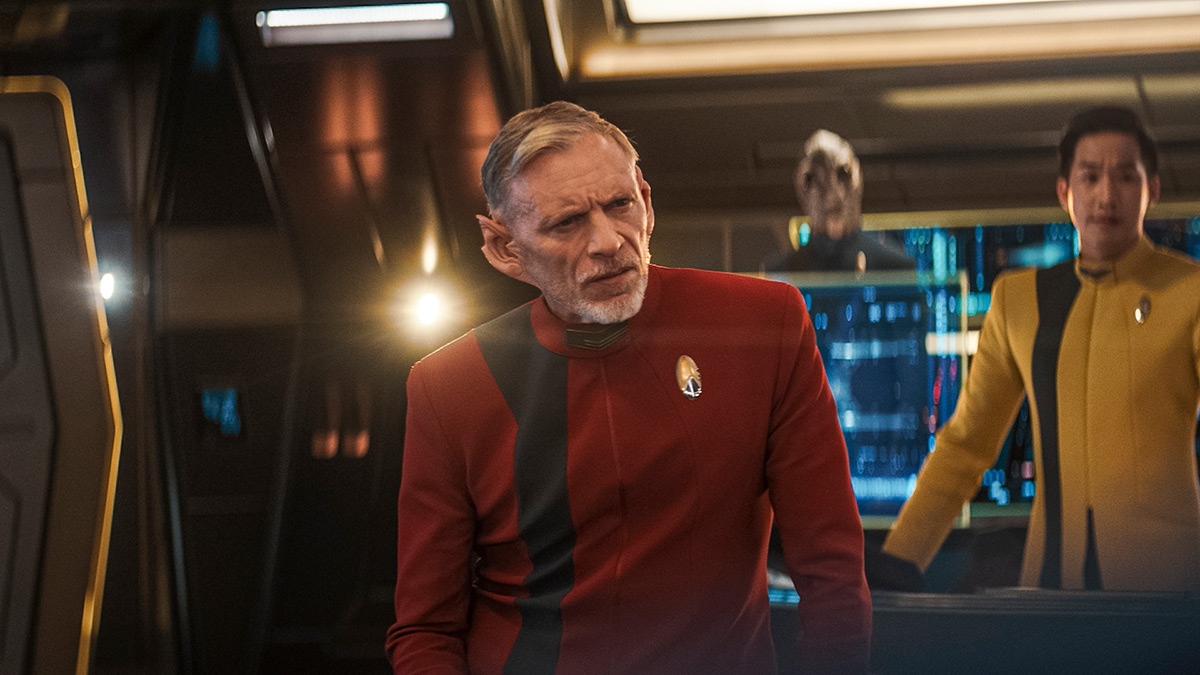
Commander Rayner (Callum Keith Rennie) isn’t thrilled by this prospect, pointing out before she leaves that it’s too dangerous a mission for a captain to undertake. But Burnham disagrees that this is enough of a reason to stop her; it’s a nice reminder that this is a show and a character that originated in the time of James T. Kirk, a time when captains didn’t stay behind in the face of danger.
But it’s not only that, there’s something else going on. Burnham gives Rayner permission to be blunt, quoting a classic work on Rayner’s native Kellerun, The Ballad of Krull, asking him to “serve it without a crumb of ossekat.” (As far as made-up Star Trek idioms go, that’s a pretty good one.)
It’s also the beginning of a sudden and relentless onslaught of references to Rayner’s culture, but more on that later. What’s Rayner’s problem? He’s uncomfortable with the prospect of being left in command of a ship and crew that aren’t “his.” Welcome to being second in command, buddy.
Book and Burnham take off, heading into the wormhole and finding it to be an inhospitable place. They quickly drop out of communication range with Discovery, there’s ship debris everywhere, including the wreckage of Moll and L’ak’s ship…. and what’s that, the ISS Enterprise?!
(A side note before we get too excited about that: what is the deal with all the empty space in the new shuttlecraft set, introduced in last season’s “All Is Possible”? The two pilot seats looked like they were crammed into the corner of a huge unfurnished room.)
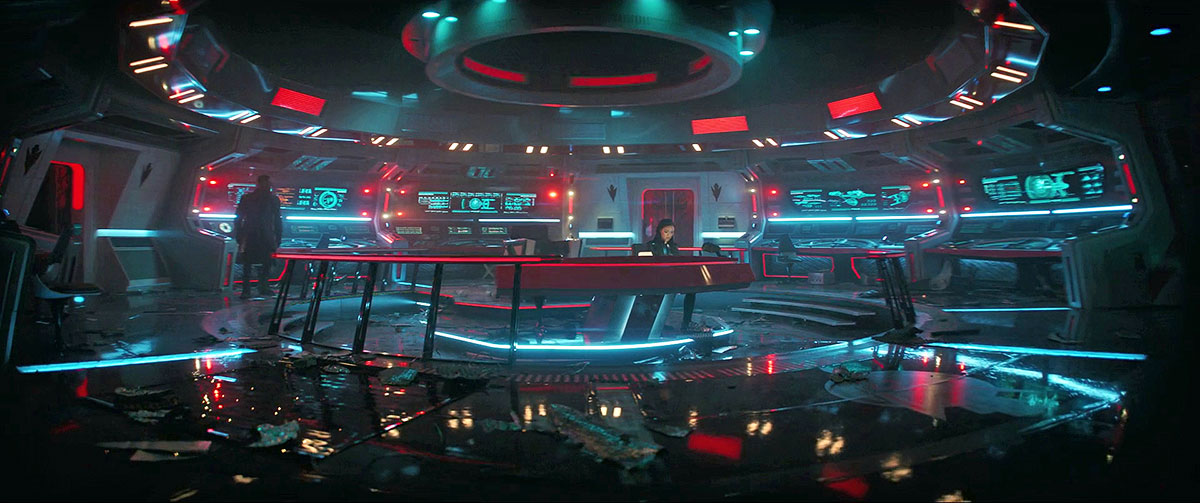
Okay, Enterprise time. Burnham and Book rightly surmise that this is where Moll and L’ak must have escaped to and beam to the ship, which of course turns out to be a redress of the Strange New Worlds standing sets. A quick scan identifies that no one else is aboard — though the clue, which Moll and L’ak have found, does also have a lifesign, hmm — and that Moll and L’ak are holed up in sickbay. Burnham takes a few moments to ponder her visit to the Mirror Universe back in Season 1 and wonder what the alternate version of her half-brother Spock might have been like (bearded, for one).
And aside from some brief storytelling about Mirror Saru’s role as a rebel leader, that’s about it for the Terran Empire of it all. Star Trek: Discovery has spent plenty of time in and around the Mirror Universe already, and I personally don’t think they need to revisit it again. But introducing the ISS Enterprise — the ship that started it all with The Original Series’ “Mirror, Mirror” — and then not doing anything momentous with it? Strange decision, and one that makes it ultimately feel more like this was a way for the show to get to reuse a set on the cheap than it does a materially significant addition to the episode.
In fact, in some ways it’s actually a detriment to the episode. If the action had been set on any other ship it would have been fine, but being on the ISS Enterprise I kept expecting something — like seeing Paul Wesley as Mirror Kirk slinking around, or finding Anson Mount camping it up as Mirror Pike in a personal log. If they’d set the action on a generic derelict ship, what we got wouldn’t have seemed like a let down. As it is though, I kept waiting for the other shoe to drop… and it simply never did.
Maybe in a subsequent episode, it’ll turn out that there’s an advantage in having an entire functional starship composed of atoms from another universe at Starfleet’s disposal — or to have a convenient collection of Constitution-class sets available for that Starfleet Academy show to borrow once in a while — but until that happens (if it even does) the use of the ISS Enterprise just seems like a name drop and a “We have to set the action somewhere, why not here?” instead of a significant use of the setting and the huge amount of lore and history that comes with it.
It’s like setting something aboard the Titanic without ever mentioning any icebergs.
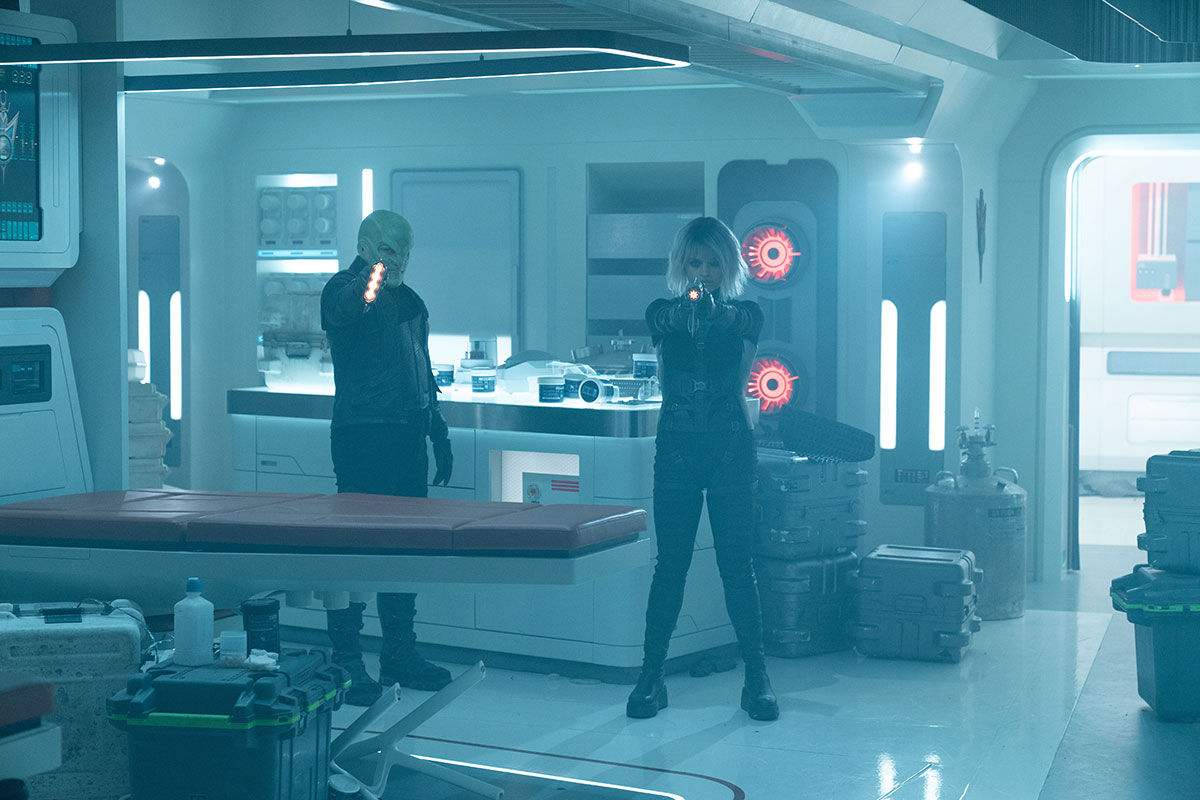
As Burnham and Book make their way down to sickbay they do find evidence that the ship was being used in a way that seemed unusually gentle for a Terran Empire vessel: signs that children and families were aboard at one time, and that they were the kind of people sentimental enough to have keepsakes and favorite stuffed animals. But again, nothing about this seems like it needs the Mirror Universe connection. Ships of people trying to escape adversity are already a Star Trek staple.
Burnham and Book find Moll (Eve Harlow) and L’ak (Elias Toufexis) in sickbay, and after a valiant but ultimately unsuccessful attempt at getting them to surrender, everyone starts shooting. Moll and L’ak have a Breen blood bounty — an erigah — on their heads and surrender is simply not an option. During the firefight a lockdown is triggered, forcefields coming down that split the group into pairs: Burnham and L’ak stuck in sickbay, while Book and Moll able to go back to the bridge to try and reset sickbay.
Pairing off also gives Book the opportunity to continue his efforts to connect with Moll, and I have to say, I don’t think I’m a fan. Setting aside the portion of this that’s purely a strategic attempt to forge a connection with someone who is very to keen to kill him, my first reaction to the way Book talks to Moll about her father (and his mentor) was distaste.
I don’t think Book meant it this way, but the way he’s written in these scenes feels unpleasantly close to the “Well, he was a great guy to me, I never saw him do anything bad” response that’s sometimes made to accusations of misconduct. A person can be wonderful to some people in their life and terrible to others; both experiences are true for the people who received them, but they’re not mutually exclusive.
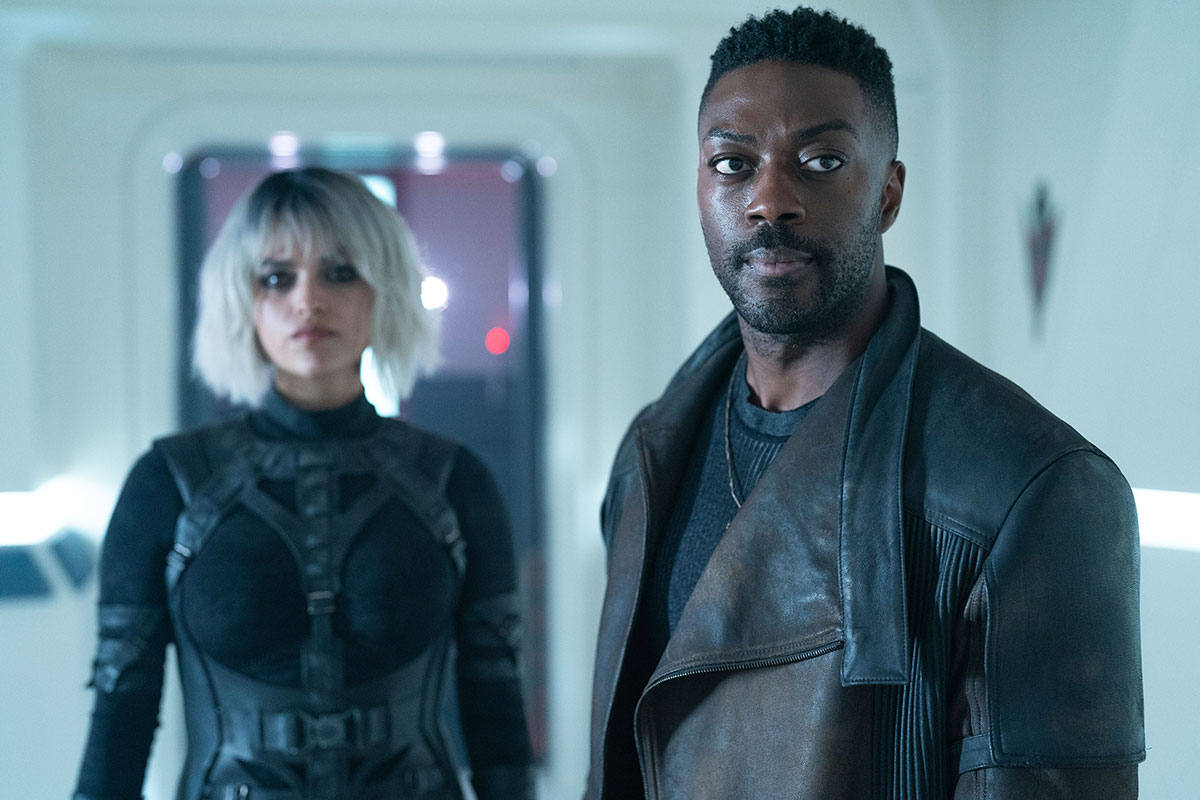
Book is preternaturally empathetic, and yet he doesn’t seem to see how continually assuring Moll that her father loved her is an act that’s both unwanted and actively painful for Moll to hear. I understand that Book is just trying to bring a sliver of comfort to Moll – but in the process he’s dismissing her own experiences of her father and his place in her life. Unless Moll asks him for this, it’s really none of Book’s business.
I suspect they’re setting up Moll’s character for a nice, cathartic arc where she comes to terms with her life, forgives her father, releases her past, whatever. And when that happens in real life that’s great — but it doesn’t always, and that’s okay too. If Moll never sees in her father the man Book saw in his mentor, it’s not a character failing. Discovery is really hammering home the theme of confronting one’s past in order to take control of one’s present and future, and I think it would be valuable if they included an example of a character learning to do the latter… without having to be okay with the former.
And to return to a question I posed in my review of “Under the Twin Moons,” I know Book is isolated and excruciatingly lonely after the destruction of Kweijan and his split with Michael, but the weight he’s placed on his relationship with Moll as “the closest thing he has to family” seems like he’s setting himself up for disappointment. Maybe I’m just a cynic, but this does not feel like a hopeful storyline to me. Not everyone wants to be family, and right now it doesn’t seem like Moll’s been given much of a choice in the matter — despite her frequent and very powerful explanations of why she’s not interested.
Clearly frustrated with Book’s topic of conversation and desperate to return to L’ak, Moll makes a reckless decision to brute-force a solution and overload some circuits. It works, and the forcefields in sickbay come down, but it also sends the Enterprise onto an unstoppable collision course with the too-small-to-pass-through and also going-to-be-closing-forever-soon wormhole. They’ve got eight minutes to figure this out.
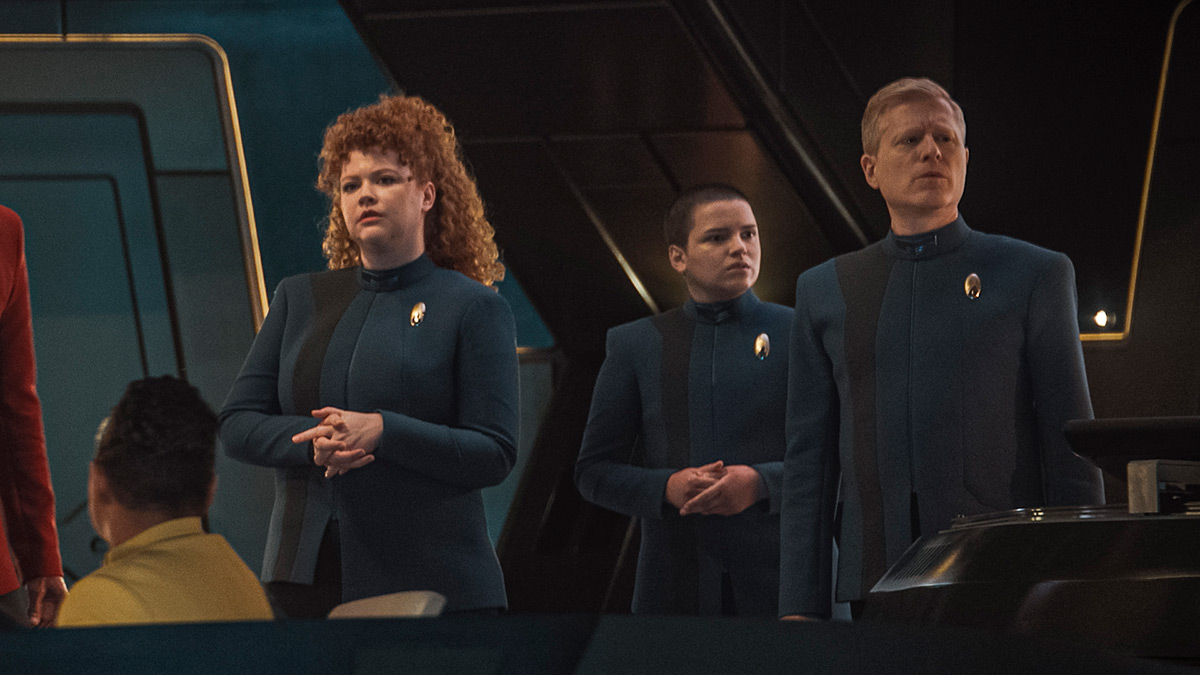
Meanwhile aboard Discovery, we see Rayner’s struggles to interact with the crew. This thread could have gone so many different ways, Rayner seeming “too good” for a temporary command, him seeing this as his chance to do things “better” than Burnham or show how it’s “really done,” but instead the show takes the much more subtle and satisfying route: Rayner is deeply respectful of the captaincy, as a rank and a role, and really doesn’t want to step on Burnham’s authority.
He’s more than willing to disagree with her on command decisions, but he doesn’t question her command. And more personally, he doesn’t want his gruffness and lack of experience with this crew to cause problems. He’s trying, in his own Rayner way, and more importantly he’s succeeding — and, as we see as he shepherds the crew through figuring out how to communicate with and then rescue Book and Burnham, the crew does their part and meets him halfway.
Rayner is learning that he needs to tone down his temperament just enough that he doesn’t come across as an actual asshole to this crew, and the crew is learning that his gruffness isn’t a sign of disrespect but simply a desire to cut to the chase and get to direct, actionable information with a minimum of fluff. There are shades of Nimoy’s Spock or Voyager-era Seven of Nine here, but couched within a distinctly different temperament, and it’s fascinating to watch. I’d love to have seen him interacting with the crew of the Antares, where he presumably felt more comfortable.
The interpersonal stuff with Rayner and the crew is great; where Rayner’s thread feels distractingly like a box being checked is the explosion of “Rayner is a Kellerun!” being shouted from the bulkheads. I could practically hear the writers yelping out a panicked “Oh crap, we forgot to say what kind of alien Rayner is!”
Again, Discovery is back to its old self with the clunky, heavy-handed, and oddly paced character work. Rayner goes from having zero cultural touchstones to having about five in the span of the 15-20 minutes of screentime that his story gets this week. They’re good touchstones, don’t get me wrong — I’m skeptical of Kellerun citrus mash, I have to be honest, but I’d give it a try; not so sure about boiling a cake though — they’re just very present.
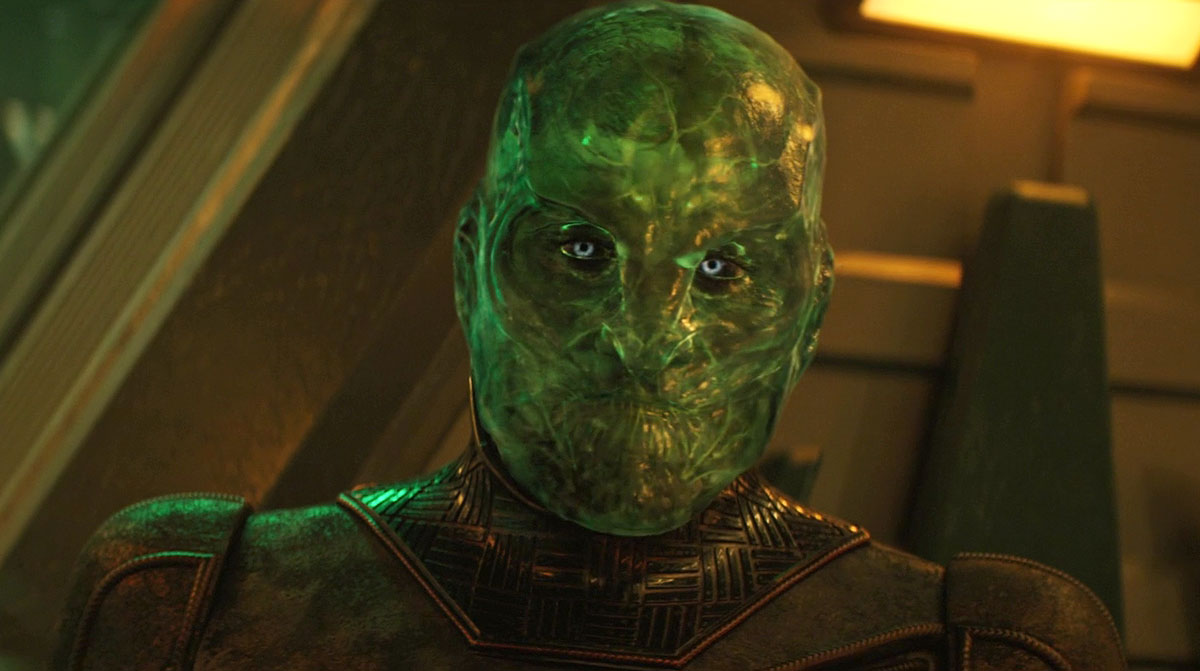
As with Rayner’s alienness, the frequent flashbacks throughout the episode to Moll and L’ak’s meeting and courtship feel like a “We forgot to explain this and now we’re trying to reference it!” correction. The content of the flashbacks is fine, there’s a lot of interesting Breen worldbuilding for a species that’s been mysterious from the start — and watching Moll and L’ak’s relationship grow from one of mutual convenience to one of true love is genuinely moving. But the way it’s woven into an episode that, again, feels like it’s composed of bits and pieces of storyline, makes it hard to shake the sense that I was watching a To Do list get checked off.
By the time the season is over it might be clear that there was simply no extra room to give a full episode over to Moll and L’ak’s meeting, or maybe an episode without any of the main cast wasn’t something they were willing or contractually able to do, but I would have loved if these flashbacks were pulled out and expanded into a full-length episode of their own. Some of the worldbuilding felt hasty to the point of hindering the emotional beats — at times I wondered if I’d forgotten a whole bunch of Breen lore and at others I was just trying to keep up with what was going on.
For example, my confusion about L’ak’s comment about having two faces, which Moll seemed to completely understand — “Duh, everyone knows the Breen have two faces” — was a distraction in the middle of an otherwise nice and significant moment. This is later clarified as the translucent face and the solid face, but again I was distracted from fully appreciating an interesting bit of Breen culture because I was busy applying what I’d just learned back to the previous scene.
The quickly (and maybe not totally clearly articulated notion) that Breen deliberately restrict themselves to their translucent form for reasons that are entirely to do with avoiding any perception of weakness is a potent if hasty bit of social commentary, and as I said I nearly didn’t catch it.
Whether holding the translucent form requires the armor for protection or the armor necessitates the translucent form — it seems like it would be more comfortable wearing that helmet all the time if you were the texture and consistency of lime jello — this is surely a metaphor for the increasingly rigid, isolating, and emotionally and sometimes physically unhealthy things men in certain circles feel they must do to be appropriately masculine. Seeing L’ak free himself from that rigidity is powerful.
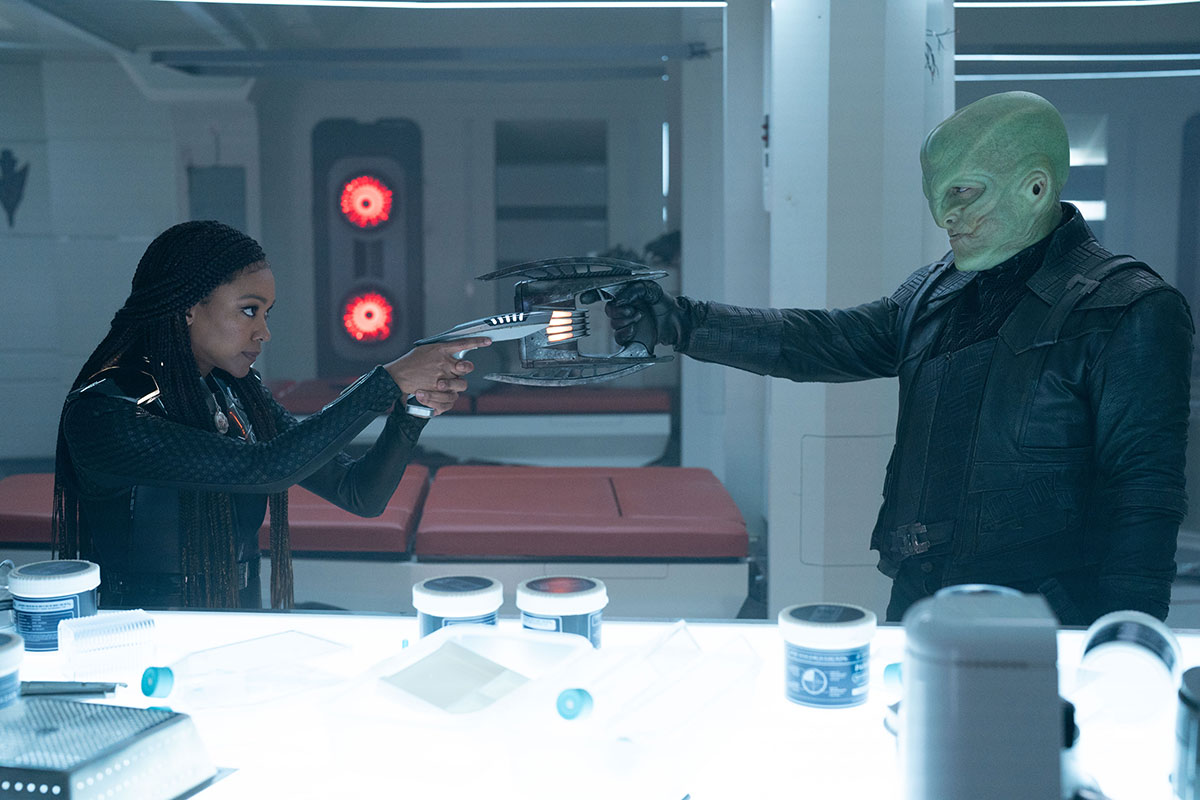
With the forcefields in sickbay down, Burnham and L’ak immediately spring into action: Burnham trying to get the artifact from L’ak and L’ak simply trying to get away. They fight, and Burnham impressively proves she can hold her own against a Breen. When L’ak accidentally falls on his own blade, Burnham grabs the clue and speeds to the bridge where she manages to get a message to Rayner through some tractor beam trickery. The message? Another reference to that classic of Kellerun literature that gives Rayner the info he needs. Hey, did you know Rayner was a Kellerun?
The ISS Enterprise makes it through the wormhole, Moll and L’ak zip away in an escape pod, and it’s time to wrap things up. We head to Red’s for a quick but significant moment between Tilly (Mary Wiseman) and Culber (Wilson Cruz), as Tilly offers advice and an ear to a Culber who’s going through a quiet existential – maybe also spiritual? – crisis.
OBSERVATION LOUNGE
- In addition to the dedication plaques on the bridge, the ISS Enterprise has an additional plaque in its transporter room — one which, despite recounting the heroism of rebel action hero Mirror Saru, still states “Long Live the Empire.”
- The transporter room plaque is marked with “Stardate 32336.6,” which is about 9 years before the events of “Encounter at Farpoint.”
- The plaque describes the fate of Mirror Spock, who was killed after instituting the reforms which later led to the fall of the Terran Empire (as described in DS9’s “Crossover”).

The full text of the ISS Enterprise transporter room plaque:
The new High Chancellor presented hope and justice as if they were natural to our world. His words, “The light of hope shines through even the darkest of nights” became our rallying cry. He spoke of reform, and changed many of us. But some saw this as weakness. They killed him, and we sought help from an unlikely ally: A Kelpien slave turned rebel leader.
He spoke of visitors from another world… a near perfect mirror cast our darkness into light. With his aid we secured the Enterprise and stayed behind to continue his work. We bear scars from our escape, but our hope remains. May it carry us into a pristine, peaceful, and just future.
- Not counting L’ak’s previous appearances this season, this episode marks the first time we have seen the Breen in live action since their involvement in the Dominion War in Deep Space Nine. (The species has appeared in Star Trek: Lower Decks three times.)
- The 32nd century Breen wear updated encounter suits clearly based on the designs introduced in Deep Space Nine; their digital speech is extremely faithful to the incomprehensible noises Breen soldiers have spoken in past appearances.
- Given the fact that Moll appears to be just fine in the environment of the Breen ship, I guess Weyoun was right when he said the Breen homeworld was “quite comfortable” in “The Changing Face of Evil.”
- When L’ak is stabbed he gently oozes some green goo — but as we learned in “In Purgatory’s Shadow,” Breen do not have traditional humanoid blood.
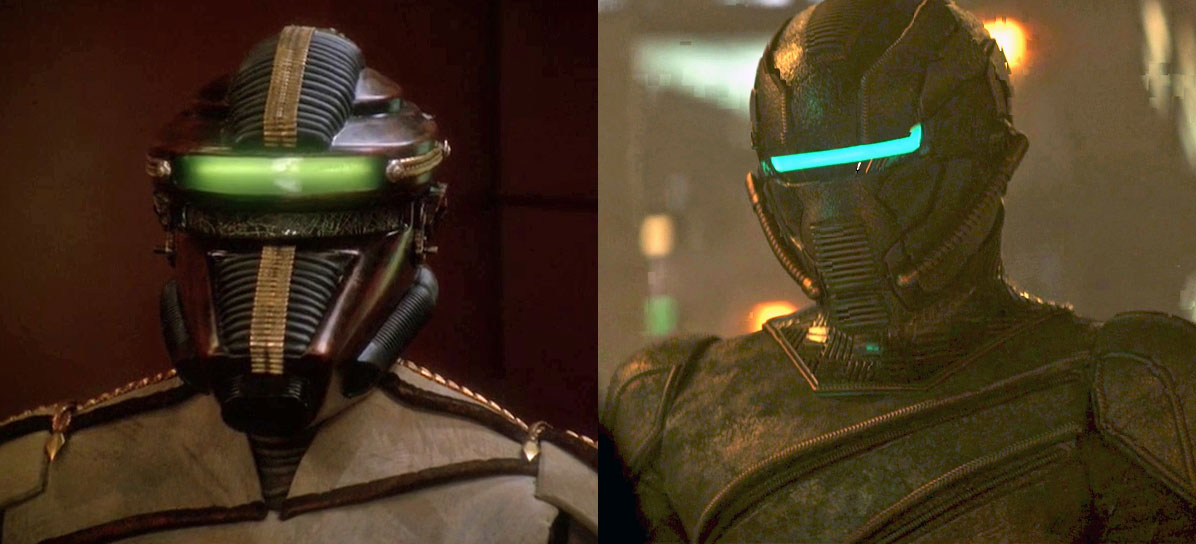
- During his time in command of Discovery, Rayner never sits in the captain’s chair.
- This episode closes with a dedication plaque that reads “In loving memory of our friend, Allan ‘Red’ Marceta”. Marceta was, I presume, the namesake for Discovery’s bar.
- Someone aboard Discovery keeps a Cardassian vole as a pet. Going by Tilly’s reaction, and what we know from Deep Space Nine, this is not a good thing.
- Linus (David Benjamin Tomlinson) plays a mean piano.
- Owosekun and Detmer get the off-screen cherry assignment of flying the ISS Enterprise back to Federation Headquarters, alone. I’m thinking that’s going to inspire some fanfic…

We don’t learn what this week’s clue is, though we know there’s a blue vial tucked away inside it, but we do learn that the crew of the ISS Enterprise did indeed make it to our universe. The scientist responsible for hiding this particular clue there was one of them, a Dr. Cho, who eventually made it all the way to branch admiral.
They strove for something positive and succeeded against all odds. Hopefully Discovery will be able to do the same as they continue their pursuit of Moll, L’ak, and the Progenitors.
![]()
Star Trek: Discovery Season 5 returns with “Whistlespeak” on Thursday, May 2.
